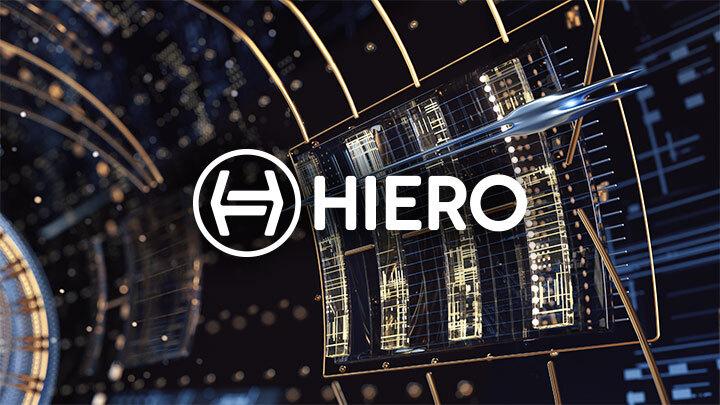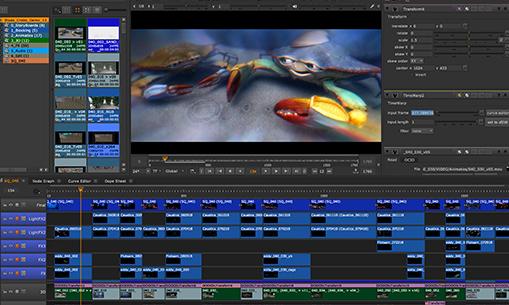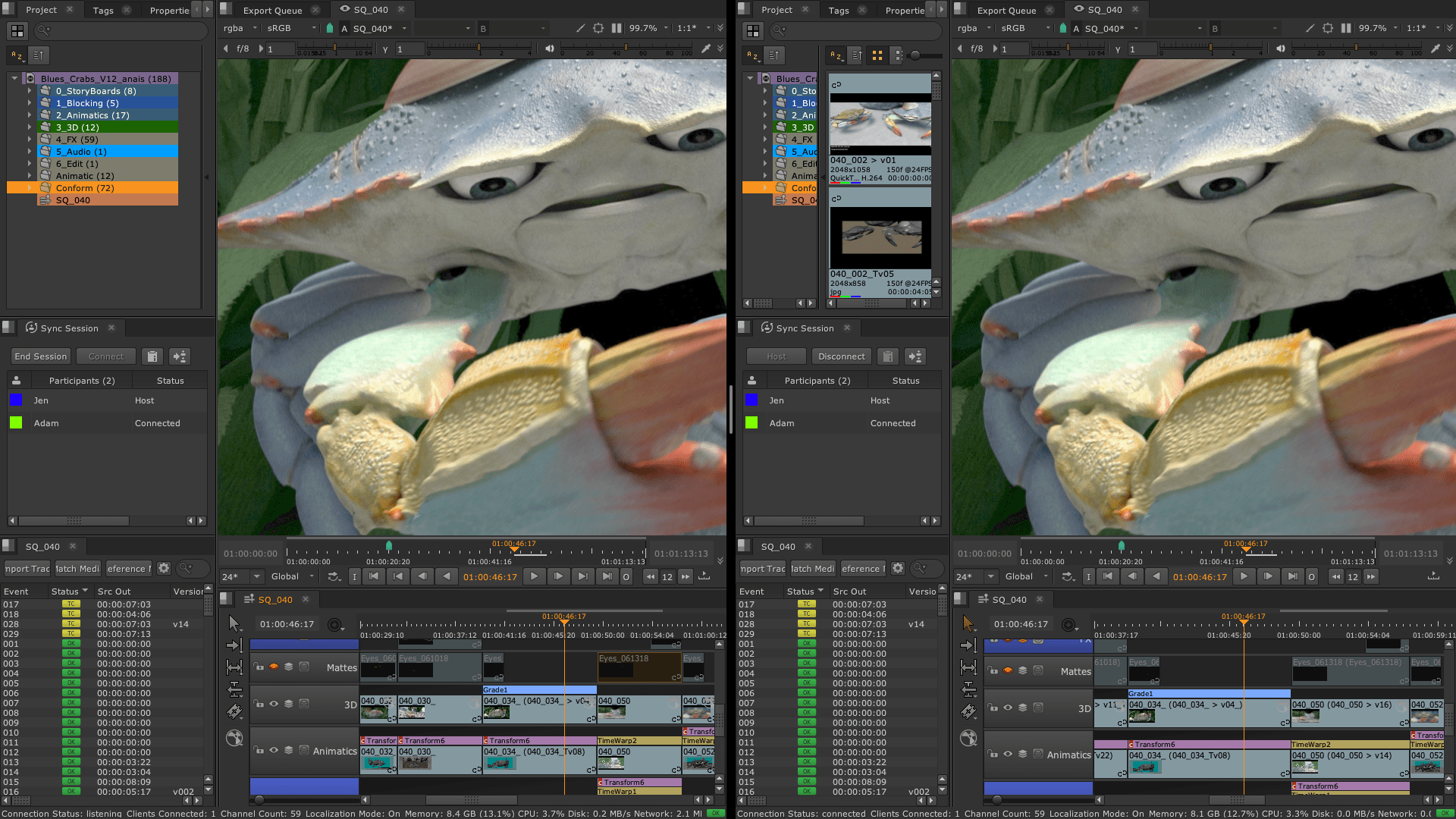コラボレーション
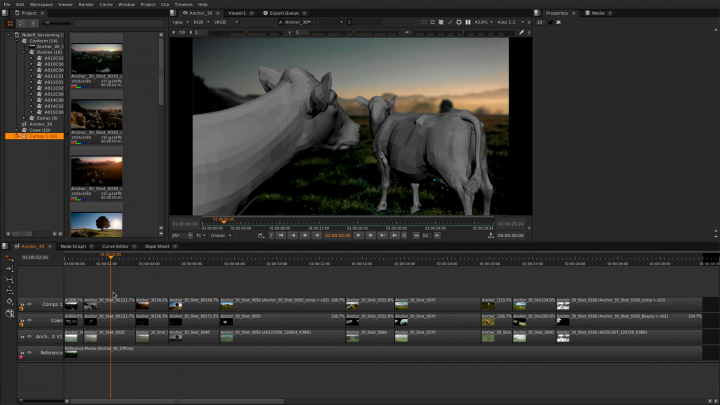
シームレスな映像編集ワークフロー
Hiero の強力なバージョン管理機能により、タイムライン上でショットの新しいバージョンを簡単かつ迅速に取り込んで切り替えることができます。これにより、異なる工程の作業や複数のアーティストによる成果物も、スムーズに比較・レビューすることが可能になります。ソースクリップのバージョンは、プロジェクトビン内のアイテムと対応するトラックアイテムの間でリンクされており、プロジェクトビンまたはシークエンス上でバージョンを変更すると、同じシークエンス内にある同一クリップのすべてのインスタンスに反映されます。これにより、バージョン管理の手間が大幅に軽減され、作業の効率化につながります。
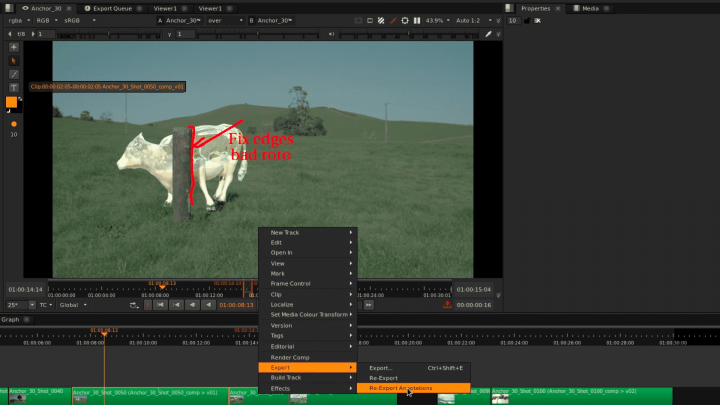
アノテーション
アノテーション機能を使えば、ショットごとにコンポジットの指示やフィードバックを視覚的にわかりやすく伝えることができます。Hiero のビューワー上で直接描き込みやメモを追加でき、Nuke や HieroPlayer を通じてチームメンバーと簡単に共有することが可能です。また、アーティストは Sync Review セッション中にアノテーションをリアルタイムで作成・編集することも可能です。
2Dフォーマット対応
Hiero は、読み込み・書き出しの両方において、幅広い 2D フォーマットに対応しています。対応形式には、DPX、EXR、JPEG、MXF、QuickTimeに加え、各種RAWカメラフォーマット(RED RAW、ARRI RAW、Sony RAW など)が含まれます。
ネイティブフリップブック
Nuke および NukeX のネイティブなフリップブックパネルや、Nuke Studio のタイムライン上で、リアルタイム再生をスムーズに行えます。再生機能には、音声対応をはじめ、複数の表示オプション、ブレンドモード、カラーピッカー、スプリットワイプツール、ガンマ/ゲインスライダーなど、充実したツールが搭載されています。
Nuke Assist
現在のメンテナンス契約には、Nuke Assist のライセンスが 2 本含まれており、ペイント、ロトスコープ、2D トラッキング、平面トラッキングなど、日常的な作業に必要な主要ノードが利用できます。これにより、基本的な作業をチームで分担したり、作業量に応じて柔軟に対応することが可能です。詳しくは、Nuke の FAQ をご覧ください。
エクスポート構造
Hiero の強力なエクスポート構造は、個人作業にもチームでの共同作業にも対応した、整理されたワークフローの基盤を提供します。シンプルなショット管理ツールとして機能し、共有ディレクトリの作成や命名規則の自動化により、ショットの共有や複数納品の管理を迅速かつスムーズに行うことができます。
バージョニング
Hiero の優れたバージョン管理機能を使えば、ショットの新しいバージョンをタイムラインに取り込み、すばやく簡単に切り替えることができます。これにより、制作の異なる段階での作業や、複数のアーティストによる成果物をスムーズに比較・レビューすることが可能になります。
レビューと再生
Hiero および HieroPlayer ののタイムライン上で、リアルタイム再生をスムーズに行えます。再生機能には、音声対応をはじめ、複数の表示オプション、ブレンドモード、カラーピッカー、スプリットワイプツール、ガンマ/ゲインスライダーなど、充実したツールが搭載されています。
Sync Review
Sync Review は、チームでの効果的なレビューを実現する新しいコラボレーション機能です。Nuke Studio、Hiero、HieroPlayer のセッションを無制限に接続し、ローカルでもリモートでもプロジェクトを全体の流れに沿ってレビューできます。再生やアノテーションの追加、編集作業まで、レビュー中のあらゆる操作をリアルタイムで同期しながら進めることが可能です。
アノテーション
アノテーション機能を使えば、ショットごとに視覚的にノートを追加し、フィードバックを行うことができます。Hiero のビューワー上で直接描画や書き込みを行い、そのコメントを Nuke スクリプトや HieroPlayer ファイルとして、ショットを担当するアーティストと簡単に共有できます。
編集
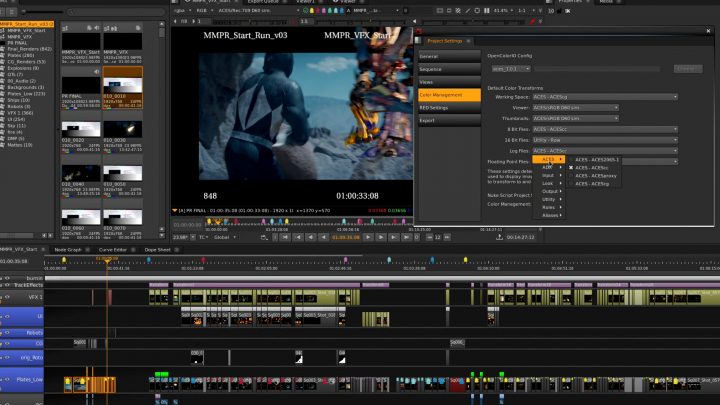
マルチトラック編集タイムライン
Hiero と HieroPlayer には、映像、CG、音声などの複数の要素を組み合わせたシークエンスを再生・レビュー・編集できるマルチトラック編集タイムラインが搭載されています。

SDIブロードキャストモニターをサポート
Hieroは、互換性のあるAJA および Blackmagic の SDI 出力ハードウェア上で、SDI ブロードキャストモニターをサポートしています。この機能により、レビューの過程でブロードキャストコンテンツのカラースペースやアスペクト比を正確に確認することができます。
SDIブロードキャストモニター対応
Hieroは、互換性のあるAJA および Blackmagic の SDI 出力ハードウェア上で、SDI ブロードキャストモニターをサポートしています。この機能により、レビューの過程でブロードキャストコンテンツのカラースペースやアスペクト比を正確に確認することができます。
VRヘッドセットによるレビュー
Nukeは主要なVRヘッドセットに対応しており、プロジェクトを外部のレビューアプリに書き出すことなく、NukeのビューアやNuke Studioのタイムライン上でそのまま再生・確認できます。対応するデバイスには、WindowsでのHTC ViveやOculus Rift CV1のほか、Windows、Mac、Linuxの各OSで使用できるOculus Rift DK2が含まれます。
スプレッドシートビュー
Hiero に搭載された高機能なスプレッドシートビューでは、タイムライン上の各アイテムのソースと出力先を視覚的に確認・編集できます。タイムラインで選択したアイテムはスプレッドシート上でも自動的に反映され、スプレッドシート側の選択もタイムラインに反映されます。オンライン編集とオフライン素材の比較もスムーズに行え、タイムコードごとのグループ単位で調整できるため、より高精度なコントロールが可能です。
タグ付け
Hiero のタグ機能を使えば、ショットやメディアにタグを付けて、簡単に整理・検索できます。メモの追加やカスタムタグの作成、タイムライン上のショットやクリップへのメタデータの保存も可能です。
Compコンテナ
タイムラインから直接Nukeのコンプスクリプトを簡単に作成でき、すべてのトランスフォームやソフトエフェクトがNukeノードに変換されます。タイムラインのCompコンテナは特定のクリップのNukeスクリプトにリンクしており、コンプスクリプトのバージョンを切り替えてタイムラインで作業をプレビューすることも可能です。
オンライン編集 & コンフォーム
Hiero は、AAF・EDL・XML をマルチレゾリューション対応のマルチトラックタイムラインへとコンフォームし、オーディオも含めて再構成します。インポートした XML や AAF ファイルに含まれるソフトエフェクト(ノンリニアリタイミング、トランスフォーム、クロップなど)も保持され、Nuke Studio 上で自動的に再現されるため、煩雑になりがちなコンフォーム作業を大幅に効率化できます。
タイムライン内のソフトエフェクト
Hiero のタイムライン上で、グレーディング、キーイング、トランスフォームなどの高性能な GPU アクセラレーションエフェクトをリアルタイムに追加できます。タイムライン上で直接ソフトエフェクトを適用することで、ショットのセットアップやアイデアの試行、作業のインタラクティブな微調整が可能になります。Hiero や Nuke Studio で作成したソフトエフェクトやオーバーレイは、HieroPlayer 上でも確認できます。
オーディオツール
Hiero や HieroPlayer のプロジェクトに .WAV や .AIFF ファイルに取り込んで再生し、音声と映像の同期を確認しながら、ショットのレビューや編集作業をスムーズに進めることができます。Hiero では、ハンドルでの調整やクロスフェード、フェードイン/フェードアウトの適用も簡単に行えます。
マルチトラック編集タイムライン
Hiero と HieroPlayer には、映像、CG、オーディオトラックのマルチレイヤーシークエンスを再生、レビュー、編集できるマルチトラック編集タイムラインが搭載されています。
パフォーマンス & パイプライン
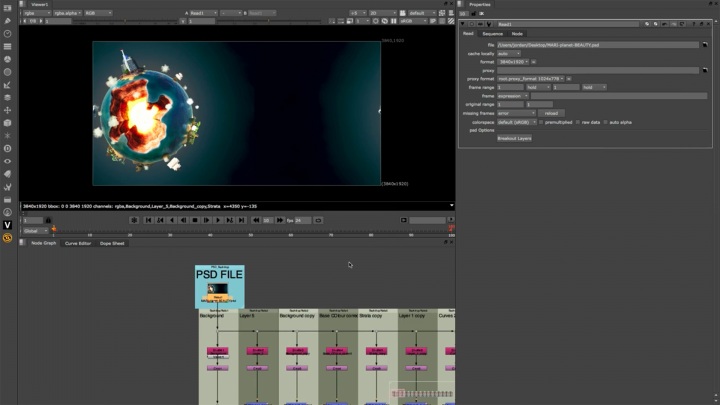
Python API と PySide
Python APIはNukeファミリーのすべての製品で利用可能で、パイプラインを完全に統合し、一般的なタスクや手順を自動化することができます。さらに、PythonとQtフレームワークを組み合わせたツールキットPySideを使えば、独自のGUIを作成することができます。
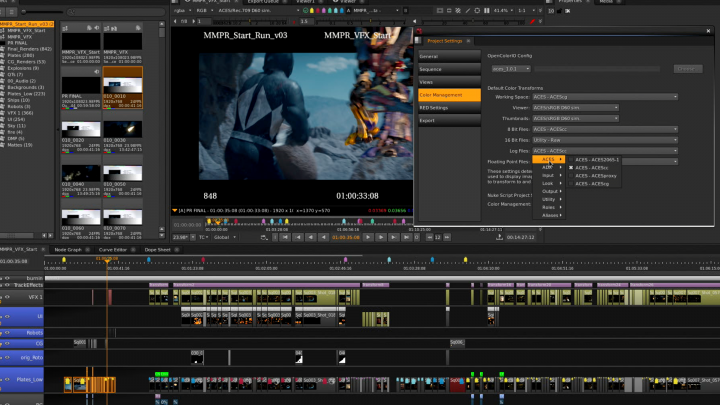
OpenColorIO カラーマネジメント
OpenColorIO(OCIO)は、Sony Picture Imageworksが開発したオープンソースのカラーマネジメントソリューションです。OCIOを使用すると、Hieroは全ての互換性のあるアプリケーション間で一貫したカラーを提供する単一のプロファイルを設定し、カラーマネジメントプロセスを簡素化することができます。
Blink Script
Blink Scriptノードを使用すると、HieroやNuke Studioのタイムラインで使用するためのCPUまたはGPU対応の独自エフェクトを作成できます。APIにより、C++プラグイン開発者はFoundryのBlinkテクノロジーを活用し、より高速で複雑なエフェクトを作成できます。
Blink GPU アクセラレーション
Blinkフレームワークは、Nuke内でのGPUアクセラレーションを提供し、モーションブラー、Kronos、デノイズ、OFlow、ZDefocusなどのツールを使用する際のインタラクティブ処理を高速化します。GPUが利用できない場合は、自動的に CPU 処理に切り替わります。
32ビット浮動小数点カラーチャンネル
Nukeの強力で拡張性に優れた、解像度に依存しないマルチチャンネルパイプラインにより、任意のイメージサイズでの読み取りと出力が可能になり、1,000以上のユーザー定義の32ビット浮動小数点カラーチャンネルを管理できます。また、Nukeのマルチスレッド化されたスキャンラインベースのレンダリングエンジンにより、超高解像度の映像でもより高速で正確な結果が得られます。
マルチチャンネルワークフロー
強力なマルチチャンネルワークフローにより、単一ストリームでのマルチパスレンダリング管理や、分離した個別のレンダリングパスを用いた操作、そしてハイダイナミックレンジイメージ(HDRI)のネイティブ対応が可能になり、より効率的な合成作業が実現します。
フルHDR対応
Nukeシリーズは、浮動小数点処理パイプラインを通じてHDRIフォーマットを完全にサポートしており、品質を損なうことなく、編集や変更を非破壊的に行うことができます。
OpenColorIO カラーマネージメント
OpenColorIO(OCIO)は、Sony Picture Imageworksが開発したオープンソースのカラーマネジメントソリューションです。OCIOを使用すると、Hiero は全ての互換性のあるアプリケーション間で一貫したカラーを提供する単一のプロファイルを設定し、カラーマネジメントプロセスを簡素化することができます。
アセット管理
Nukeシリーズの全製品は、ftrackやShotgun、社内システムなどのアセット管理ソフトウェアに接続する機能を備えており、チーム内でのアーティスト間のコラボレーションがスムーズに進行し、効率的にプロジェクトを管理することができます。
スクリプトのパフォーマンス指標
Nukeのクロスプラットフォームパフォーマンスメトリクスは、遅いスクリプトのデバッグやボトルネックの発見に役立ちます。コマンドラインからNukeを実行して、レンダーの完全なパフォーマンスプロファイルをXML形式で取得するか、スクリプトでProfileノードを使用して、CPU時間、ウォール時間、操作数、メモリ使用量などのパフォーマンスデータをキャプチャします。
Python API と PySide
Python APIはNukeファミリーのすべての製品で利用可能で、パイプラインを完全に統合し、一般的なタスクや手順を自動化することができます。さらに、PythonとQtフレームワークを組み合わせたツールキットPySideを使えば、独自のGUIを作成することができます。
ステレオスコピック(立体視)ワークフロー
Nuke Studioは任意の数の画像ストリームをネイティブにサポートしており、複数のカメラビューを簡単に操作できます。ベースアプリケーションに組み込まれた効率的なステレオスコピックワークフローにより、ネイティブステレオポストプロダクションに必要な機能がすべて揃っています。
What's New
Foundryの製品リリースやその他最新情報をご確認ください。
Hieroを体験する
Hiero は、マルチショット管理、コンフォーム、編集、レビュー機能を統合した高機能ツール。レビュー ワークフローの効率化を実現します。
Hiero を Nuke ファミリーの一環として活用すれば、タイムラインをシームレスに共有でき、より高い視認性と管理性を実現できます。
